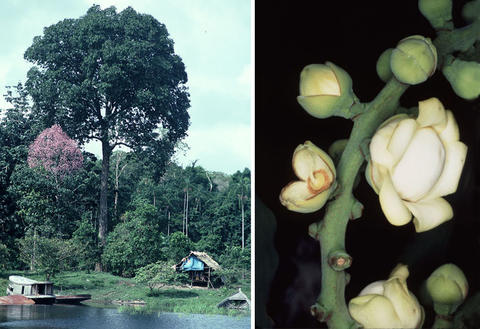This article was contributed by Scott A. Mori

The Brazil nut is the largest nut in a can of mixed party nuts. It is the seed of a tall Amazonian tree first discovered by Europeans by Alexander von Humboldt and Aimé Bonpland natural history expedition to the New World from 1799-1804. It was subsequently published as Bertholletia excelsa by Bonpland in 1808. The Brazil nut is not a nut, which in botany refers to a specific kind of fruit, but a seed that comes from a cannon-ball like, woody capsule (a fruit that naturally opens to release the seeds). The natural history of a Brazil nut is one of the marvels of tropical nature.
POLLINATION
The flower is large and fleshy and its stamens are arranged in a manner not found in any other plant family on the planet. There are fertile stamens found in a ring at the summit of the ovary that surrounds the style. The ring has a prolongation called the hood which develops from the side of the flower closest to the axis on which it is borne. At the apex of the hood are appendages that turn inward toward the interior of the hood . At the point where these appendages arise from the inside of the hood a small amount of nectar is produced. The fleshy hood presses directly onto the summit of the ovary and the six petals form an overlapping "cup" that closes entry to the flower from all but the strongest pollinators. The Brazil nut is only known to be pollinated by bees with enough strength to open the hood. Bees documented to enter the flower are robust bees of the genera Bombus, Centris, Epicharis, Eulaema, and Xylocopa which are presumably rewarded for their efforts by the nectar they collect from the interior of the hood. While in the flower, pollen is placed on their heads and backs from where it is rubbed off on the stigma of subsequent flowers visited. Self-compatibility is low in Brazil nut trees so fruits are mostly the result of cross-pollination.
DISPERSAL
At maturity the large, round, woody fruits of Bertholletia excelsa fall to the ground with from 10 to 25 seeds trapped inside. The seeds are removed from the capsules and are dispersed by agoutis (a rodent about the size of a large cat) and less frequently by squirrels. It has been demonstrated that agoutis in areas in southeastern Brazilian Amazonia with Brazl nut trees are more abundant and have smaller home ranges than agoutis in areas without Brazil nut trees. Because the seeds are protected by the woody fruits and because the boney seed coats are difficult to open, only animals with sharp teeth and/or a strong bite force are able to consume them. The agoutis and squirrels eat some of the seeds and cache others for future consumption. Some of the cached seeds are forgotten by the animals, and it is these seeds that may germinate and grow into the next generation of trees.
FURTHER READING
Mori, S. A. 1992. Pages 241-251 in Plotkin, M. & L. Famolare (eds), Sustainable harvest and marketing of rain forest froducts. Island Press, Corvelo, CA.
Mori, S. A. & G. T. Prance. 1990. Taxonomy, ecology, and economic botany of the Brazil nut (Bertholletia excelsa Humb. & Bonp.: Lecythidaceae). Advances Econ. Bot. 8: 130-150.
Mori, S. A. & G. T. Prance. 2006 onward. The Lecythidaceae Pages. The New York Botanical Garden, Bronx, New York.
Ortiz, E. 1995. Survival in a nut shell. Americas September/October, pp. 7-17.
MODIFIED FROM:
Mori, S. (2008). Brazil nut (Bertholletia excelsa). Encyclopedia of Earth,
HOW-TO-CITE:
Mori, S. A. 2013. Brazil nut (Bertholletia excelsa). The Brazil nut family (Lecythidaceae). http://lecythidaceae.myspecies.info/content/brazil-nut-bertholletia-exce....
Add new comment